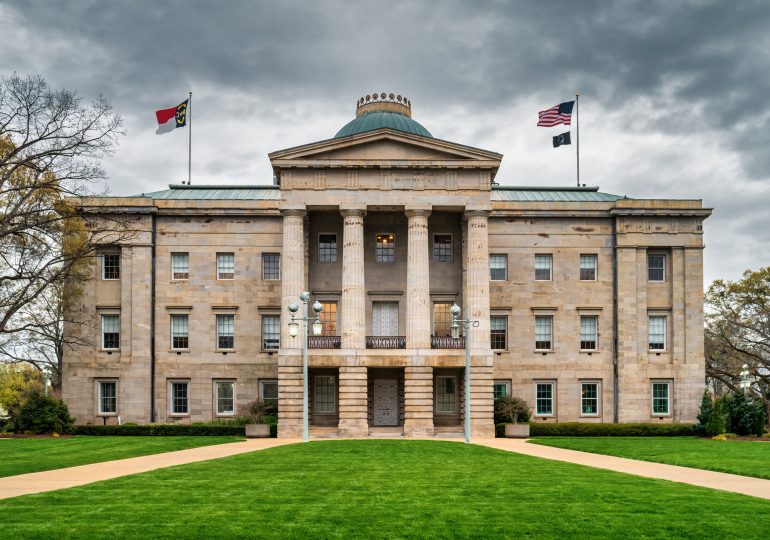The political stakes in purple states — those with small electoral margins that can swing back and forth between the two major parties — are enormous. Unlike bright blue and red states, where one party perpetually dominates all branches of government, the party in power in the small handful of competitive states is constantly worried about losing control. That creates a temptation and an incentive for the majority in the state legislature to try to alter governmental institutions to benefit their side politically.
[time-brightcove not-tgx=”true”]
Nowhere is this clearer than in North Carolina. On Wednesday, the Republican supermajority in the state house will try to override the veto of Democratic Governor Roy Cooper on a bill that threatens to reduce the power of incoming Democratic officials and fundamentally shift who controls parts of the state government. This is nothing new in the Tar Heel State, and the history of these power grabs reveals that closely contested elections often lead to the rawest and most brazen form of partisanship.
For the first three quarters of the 20th century, North Carolina — like the entire South — was rock-ribbed Democratic territory. The party controlled the General Assembly and all of the statewide Council of State offices from 1901-1972.
In 1972, voters sent shockwaves throughout the state by electing Republican Jim Holshouser governor on the coattails of Richard Nixon’s landslide reelection (in which the incumbent president won a whopping 49 states).
The arrival of North Carolina as a competitive state created the ideal conditions for power grabs. Late in 1973, Holshouser made what News and Observer columnist Martin Donsky described as “massive personnel changes in at least two agencies.” The governor dispatched surrogates by helicopter to deliver news to some Democrats that their services were no longer needed.
Not surprisingly, Democrats in the General Assembly responded by clipping Holshouser’s wings. As columnist Paul O’Connor later noted, “the Democrats stripped him of many of his powers and tried to ignore his proposals. The feuding started slowly and got progressively worse.”
Read More: Mark Robinson Loses North Carolina Governor’s Race
And, with that, North Carolinians had a taste for how competition could breed animus.
In 1976, the partisan pendulum swung back. After a robust victory, Democratic Governor-elect Jim Hunt acted quickly, firing so many Republican executive branch officials during the Yuletide season that it became known as the “Christmas massacre.” Although Republicans were taken aback at what they viewed as a power grab, they had little power in the legislative branch, which left them unable to respond with anything other than bitterness.
During Hunt’s tenure as governor, patterns emerged in North Carolina politics that would persist for decades. Republicans began to dominate presidential and U.S. Senate races, even as Democrats more than held their own in state and local contests.
Ronald Reagan was a key catalyst in this shift. As he swept to reelection in 1984, Republican Jim Martin captured the North Carolina governorship, replacing the term limited Hunt.
In April 1985, three months into Martin’s term, Democrats in the General Assembly capped the number of gubernatorial appointments at 325 and constrained Martin’s freedom to nominate election board members as he wished. Instead, they required that he follow lists given to him by the two major political parties.
One Republican senator was so fed up with the changes that he proposed an amendment dripping with sarcasm. It would have kept the executive director of the State Board of Elections, Alex Brock — a Democratic appointee — “or his heirs” in office “in perpetuity,” adding that “registration as a Republican shall be grounds for removal for cause.” As the amendment exposed, Republicans stewed over the changes, but, other than a sarcastic shot across the bow, their minority status gave them little power to respond.
Their predicament remained the same in 1989, when Jim Gardner became the first Republican Lt. Governor elected in the 20th century, and the Democratic majority promptly stripped the office of virtually all power over shepherding legislation through the state Senate. There was simply little Republicans could do about it.
Instead, they had to wait decades for a chance for revenge.
The combination of a good political environment for Republicans in the 2010 midterm elections and the Redistricting Majority Project (REDMAP) — undertaken by GOP strategists to flip state legislatures across the country in time for the 2011 redistricting cycle — catapulted Republicans to majority control of both chambers of the North Carolina General Assembly for the first time in 100 years.
Soon after they were elected, the Republican majority fulfilled the promise of Project REDMAP by drawing, well…red maps. These maps would secure Republican dominance for the next decade. When Democrats complained, Republicans pointed towards the sordid history of Democratic gerrymandering in North Carolina and argued, essentially, that turnabout was fair play.
Then, after the 2016 election, when Republican Governor Pat McCrory lost to Democrat Roy Cooper, the Republican-controlled General Assembly did something more drastic.
Returning for a lame duck session after the election, the General Assembly cut the number of gubernatorial appointments from more than 1500 to 300, removed the governor’s appointment power over University of North Carolina trustees, and required legislative confirmation of a number of key appointments.
When Democrats howled, Republicans reminded them of their own long history of power grabs. North Carolina GOP chair Dallas Woodhouse retorted, “How about when Jim Hunt tried to fire all the Republicans in the ‘Christmas massacre’?… And what about the Democrats stripping the Republican lieutenant governor of all his power? Was that right? Or stripping Gov. Jim Martin of his hiring authority?”
Read More: Gerrymandering Isn’t New—But Now We Have a Solution
Unlike the previous power plays, however, this particular move garnered national media attention. Tara Golshan at Vox called it a “shocking Republican power grab” and in the New York Times, historian Karen Cox described the state of North Carolina politics as “a situation that looks akin to the South of the 1890s.”
In the context of this history, legislative Republicans’ current maneuvering isn’t surprising. The 2024 election delivered Democratic victories for half of the council of state offices — including Governor, Lt. Governor, Attorney General, and Superintendent of Public Instruction — and broke the GOP’s legislative supermajority by one seat.
In response, as in 2016, GOP leaders brought the legislature back into session. They took a bill that was initially designed to streamline licensing for dentists who do research at medical schools, turned it into one that would provide relief for Western North Carolina counties affected by Hurricane Helene—and then added more than 120 additional pages of changes that removed power from positions held by incoming Democratic officials and gave it to ones held by Republicans.
Under this bill, appointment power over the chair of the state’s 101 boards of elections would move from the governor to the state auditor. It also would eliminate the power of the attorney general (a Democrat) to take action counter to the expressed interest of the General Assembly, while reducing the already minimal power of the newly elected Democratic lieutenant governor by taking away the office’s representation on various boards and commissions. Finally, the bill stripped the newly elected Democratic Superintendent of Public Instruction of some oversight authority over charter schools and the Center for Safer Schools.
Outgoing Governor Cooper vetoed the legislation, proclaiming it “a sham.”
Republicans in the state senate quickly voted to override the veto, but the prospects of the override attempt in the state house are murkier. On Wednesday, the GOP majority is expected to attempt to override Cooper’s veto, but there is some doubt as to whether they have the votes because three Republican members from Western North Carolina voted against the bill initially. Should they vote no again, Cooper’s veto will stand and the power grab will fail.
While the fate of this case remains uncertain, it is clear is that rather than delivering moderation and bipartisanship, electoral uncertainty in North Carolina has created the most aggressive form of raw partisanship. For decades, both parties have refused to accept losses without trying to neuter the newly elected opposition. Given the purple nature of North Carolina’s politics, the prospects of this pattern changing anytime soon are slim, and it serves as a reminder that close margins for the major parties don’t necessarily produce politicians running toward the middle.
Christopher Cooper is Madison distinguished professor and director of the Haire Institute for Public Policy at Western Carolina University. His book, Anatomy of a Purple State: A North Carolina Politics Primer, is available now from the University of North Carolina Press.
Made by History takes readers beyond the headlines with articles written and edited by professional historians. Learn more about Made by History at TIME here. Opinions expressed do not necessarily reflect the views of TIME editors.
Leave a comment








